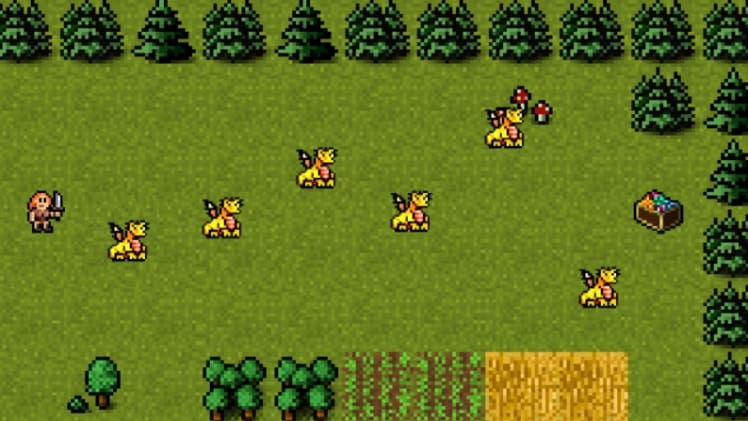As the popularity of HTML5 gaming increases, developers must understand the core principles of game design to develop engaging and immersive experiences for their players. This guide will provide an overview of the key concepts behind HTML5 game design and show developers how to apply them in their projects.
By understanding these principles, developers can create more compelling games that take advantage of HTML5’s capabilities and bring a new level of interactivity to the web. With these fundamentals under your belt, you can build interactive worlds that captivate and engage players like never before. Let’s take a look at these principles.
1. Sprites
Sprites are digital images that represent objects in a video game. They can be used for static elements, such as characters or scenery, but also to create animation. Each sprite in an animated sequence represents a different motion frame, allowing the object to move. Sprites can also be used to create user interface elements such as menus or buttons. The versatility of sprites makes them a popular choice for game designers when constructing interactive digital worlds.
Whether you’re building an engaging 3D RPG or a classic platformer, understanding how to effectively use sprites is essential for crafting unforgettable gaming experiences. A HTML5 game development company can help you create the best gaming experience possible.
2. Game Loops
Game loops are the heart of any game. They are responsible for controlling the timing and behavior of a game, as well as handling user input interactions. On each iteration, they process user input, move entities around in the game world, check for collisions between characters or objects, and appealingly render the game.
Regulating game time between each frame ensures all elements run smoothly and accurately within the virtual environment. Game loops truly make gaming possible!
3. Collision Detection
Collision detection is an essential element of HTML5 game design, allowing games to detect when two objects interact. For instance, collision detection will record if a player hits a wall or if a bullet strikes an enemy. This data can then determine what happens next in the game, such as reducing the player’s health score by 10 points when a bullet strikes them.
In this way, collision detection provides much-needed information for coding logic within HTML5 games and accurately records interactions between objects.
4. Euler Integration
Euler integration is a numerical technique that integrates equations of motion to calculate an object’s position. It relies on velocity, mass, and force to recalculate values for each tick in the game loop, making it well-suited for side-scrolling shooters.
Alternative methods, such as Verlet integration and RK4 integration are better suited for different tasks. Any game development studio should thoroughly understand these techniques to achieve the best results.
5. Particles and Particle Systems
Particles and particle systems are the most important components in HTML5 game design. Particle systems are simulated entities that create visual effects like smoke, flames, sparks, and explosions. These particles have properties such as color, size, speed, and direction that can be manipulated to create various effects. Particle systems enable developers to quickly and easily add visual flair to their games without coding complex animations.
Additionally, they allow games to render more objects on screen than possible with traditional animation techniques. Furthermore, particles are often combined with other assets, such as sprites or textures, for added realism and immersion.
6. Sprite Sheets
Sprite Sheets store a collection of individual sprites in one image. This is done to minimize the number of files the game uses, resulting in improved performance as it reduces both memory usage and processing power requirements. Sprite sheets are composed of several sprites laid out side-by-side or arranged into rows and columns, which can then be used for animation or static display. Thus, Sprite Sheets are a compact and efficient way to store multiple sprites in one image.
These can be used for 2D games or 3D models, creating the potential for more complex and detailed visuals than would otherwise be possible with individual sprite assets alone. It also allows game developers to make any desired changes to multiple sprites at once without requiring additional editing time and effort. As such, Sprite Sheets can prove invaluable in maintaining efficient development processes while still achieving high-quality visuals.
How to Choose Game Development Studio
The following tips can help you identify which game studio is the best fit for your needs:
- Be clear on what you want out of the partnership. Do you need concept, design, coding, and art assistance? Knowing exactly what services you require will help you quickly narrow the list of potential partners.
- Research multiple options. Once you know what kind of service providers fit into your scope, start looking at their portfolios and reviews to assess how they match your vision. Not all studios specialize in the same type of development, so it’s important to focus on those who specialize in your style.
- Ask questions! Before signing a contract or making any commitment, understand their process and pricing structure. You should also ask about post-launch support and what happens if things don’t go according to plan.
The Bottom Line
HTML5 game design is a powerful and versatile set of principles which could be used to create engaging and entertaining games. With the right tools and knowledge, developers can leverage the strengths of HTML5 to create visually stunning games with highly intuitive gameplay. As the technology evolves, it will become easier for developers to produce even more high-quality HTML5 games. The possibilities are endless!

